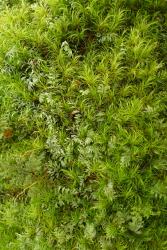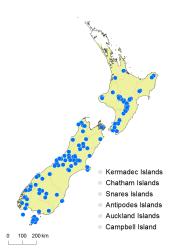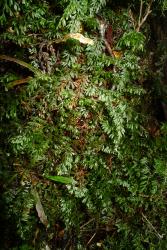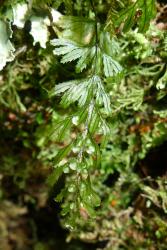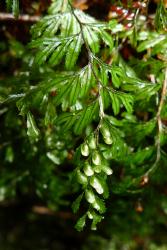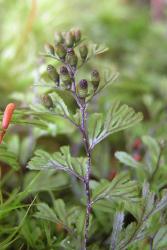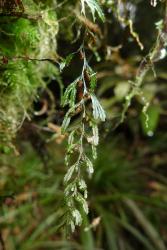- ≡ Trichomanes peltatum Poir., Encycl. 76 (1808)
- = Hymenophyllum unilaterale Willd., Sp. Pl. 5(1), 521 (1810)
- ≡ Hymenophyllum tunbridgense var. unilaterale (Willd.) G.M.Thomson, Ferns New Zealand 36 (1882)
Epiphytic, terrestrial or rupestral ferns. Rhizomes long-creeping, 0.1–0.3 mm diameter, bearing very scattered red-brown hairs up to 0.3 mm long. Fronds 20–140 mm long. Stipes 3–30 mm long, dark brown throughout, not winged, bearing very scattered hairs. Laminae 2-pinnatifid or rarely 3-pinnatifid, narrowly ovate or narrowly elliptic, 16–120 mm long, 8–25 mm wide, green, membranous, glabrous. Rachises narrowly winged throughout, brown, glabrous; rachis wings planate, margins entire. Primary pinnae in 6–15 pairs, not overlapping, winged throughout, narrowly ovate or ovate or elliptic, adnate; distal portion of primary pinnae strongly incurved acroscopically; the longest primary pinnae at or below the middle, 5–15 mm long, 2–7 mm wide. Ultimate lamina segments arising only acroscopically on primary pinnae, oblong or linear, up to 8 mm long, 0.6–1.5 mm wide; apices acute or obtuse; margins toothed, lacking a distinct border; segments on primary pinnae directed to frond apex. Sori borne on short acroscopic segments at the base of primary pinnae, solitary on each segment, 1–3 on each primary pinna, adnate; indusia bivalvate; indusial flaps usually ovate or elliptic, 1–2 mm long, apices obtuse, margins entire; receptacles included within indusial flaps or slightly exserted up to 0.5 mm.
Hymenophyllum peltatum is one of several small filmy ferns in New Zealand with toothed lamina margins. It is smaller than either H. bivalve or H. multifidum, and lacks the marginal spines on the lamina segments in H. armstrongii or the spines on the back of the indusial flaps in H. minimum. It is very similar to H. revolutum and H. cupressiforme, but distinguished from the former by its rachises which are winged throughout and its indusial flaps which are entire, and from the latter by having up to three sori on each primary pinna rather than one, by its secondary pinnae which arise only acroscopically, and by its indusial flaps which are entire rather than shallowly toothed.
North Island: Auckland, Volcanic Plateau, Gisborne, Taranaki, Southern North Island.
South Island: Western Nelson, Sounds-Nelson, Marlborough, Westland, Canterbury, Otago, Southland, Fiordland.
Solander Island, Stewart Island.
Altitudinal range: 150–1700 m.
Hymenophyllum peltatum occurs extensively in montane to subalpine areas of the North Island from Mt Te Aroha southwards, occupying an altitudinal zone from about 450 m in the Ruahine and Kaweka Ranges to 1500 m on Mt Taranaki and the Ruahine Ranges. In the South Island it occurs on both sides of the main divide, growing in lowland to alpine areas, extending from 150 m in Westland to 1700 m on Malte Brun, Mt Cook.
Also Chile, South Africa, Mascarene Islands, Borneo (Mt Kinabalu), Papua New Guinea (Mt Victoria), Australia (Queensland, New South Wales, Victoria, Tasmania), Macquarie Island (Ebihara & Iwatsuki 2007).
Grows on the ground, or on rocks, banks, fallen logs or epiphytically, most frequently in beech, podocarp forest or Weinmannia forest, or in subalpine scrub or herbfield. It has been recorded as an epiphyte on Dracophyllum traversii, Fuchsia excorticata, Libocedrus bidwillii, Lophozonia menziesii, Metrosideros umbellata and Olearia colensoi. Unusually for a species of Hymenophyllum, it has not been recorded on tree fern trunks.
n = 11 (Brownlie 1958).
A collection from the Waitakere Ranges made by Cheeseman (CHR 293698) is labelled by him as H. cheesemanii (= H. armstrongii). However, the sheet includes material of both H. armstrongii (at the top) and H. peltatum (in the centre). The latter species is not known from the Waitakere Ranges today (Peter de Lange, pers. comm.), no other collections north of Mt Te Aroha are known, and it is unlikely to have been collected from Waitakere by Cheeseman. The sheet is from the Carse Herbarium and the specimen of H. peltatum was probably added in error after receipt from Cheeseman.



